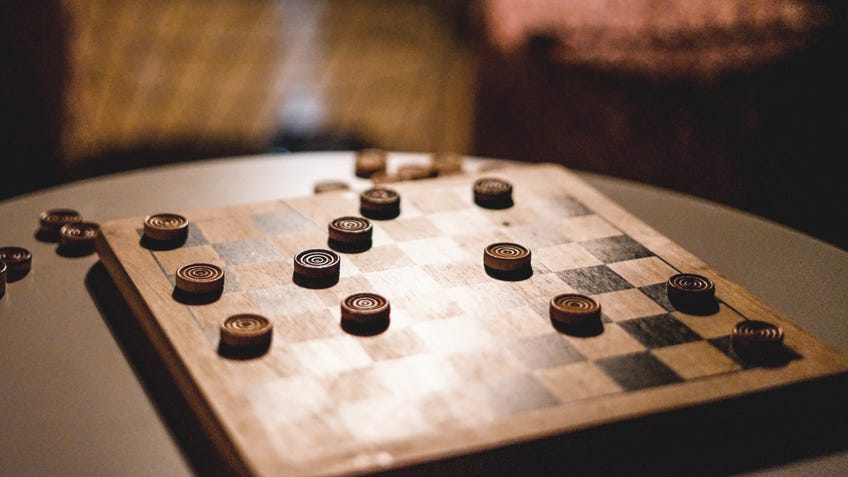How to play checkers: Draughts rules and jumps explained
Learn the basic rules of checkers and get tips on how to win in our beginner's guide.
Checkers is one of the oldest known board games that is still played today. Also called draughts in Blighty, the origins of the game can be traced back thousands of years to ancient Mesopotamia.
While the playing field looks similar, checkers is a much faster game with less rules to remember and easier to get into - but still requires thought and planning. If you're thinking of starting your first game of checkers or you're looking for a refresh of the rules then our guide on how to play checkers is here to help.
How to play checkers
- Checkers setup
- Checkers rules
- Jumps explained
- Kings explained
- How to win at checkers
- Checkers strategies
Our beginner-friendly guide has everything you need to know to get started in a game of checkers. From how to setup the board to the basic rules, we'll guide you through your very first game and beyond.
Not sure how jump moves work or how to turn one of your pieces into a King? Our step-by-step guide will explain these rules in detail, and then we'll take a deep dive into some of the strategies you can deploy if you're looking for tips on how to win.
How to setup a game of checkers
.jpg?width=848&quality=80&format=jpg&auto=webp)
To start with, place the checkers board on a table with players sitting at opposite ends. Like with chess, only two people can play at a time.
An American checkers and British draughts board is made up of an 8x8 grid with alternating light and dark squares. You will want to position the board so the square in your bottom left is a darker square.
Next, you will need to decide which player goes first. In checkers whoever controls the darker pieces begins. Pieces are typically coloured white and black but you can get sets with red and white counters.
Decide who takes the darker pieces through a coin toss, a game of rock, paper, scissor or another method. Once this is sorted, lay out the pieces.
Each player has 12 pieces and these need to be placed on the dark squares in the three closest rows. After you've done that, decide if you want to time each move. In tournaments the standard timing is five minutes per move but you don't need to do this.
What are the rules of checkers?
Players take alternating turns in checkers with one piece moved at a time. Pieces are moved diagonally between the dark coloured squares, and are typically moved one square at a time. Once you touch a piece you have to move it so be sure of your move beforehand.
You cannot move a piece horizontally, vertically or onto a lighter coloured square. Standard pieces can only move forwards (i.e towards your opponent's side of the board) and cannot move backwards. Once a player has moved a piece, their opponent's turn begins, and so on until the game is won or it ends in a draw.
And a game is genreally won when the all the opponent's pieces have been captured. So far, so simple. But the depth and complexity in checkers comes from how jumps and King moves work.
How do jump moves work in checkers?
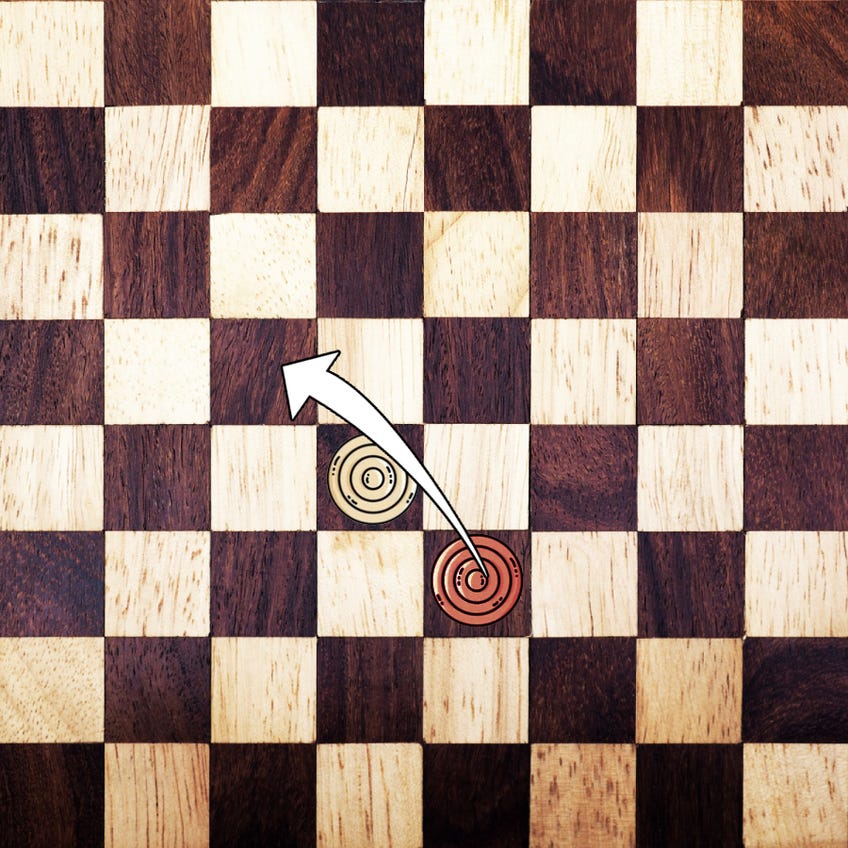
We previously said pieces "typically" move one square at a time. That's because the jump rule allows pieces to move multiple squares in one turn.
Jumps are critical to winning in checkers as it allows a player to attack one of their opponent's pieces and remove it from the board. You can perform a jump when you have a piece on the board that's diagonally adjacent to one of your opponent's with an empty space behind it.
When this happens, take your piece and jump it over your opponent's piece and place it on the empty space behind. Then, remove the checker you just attacked from the board and put it to one side. You cannot jump over your own pieces.
What jumps are allowed in checkers?
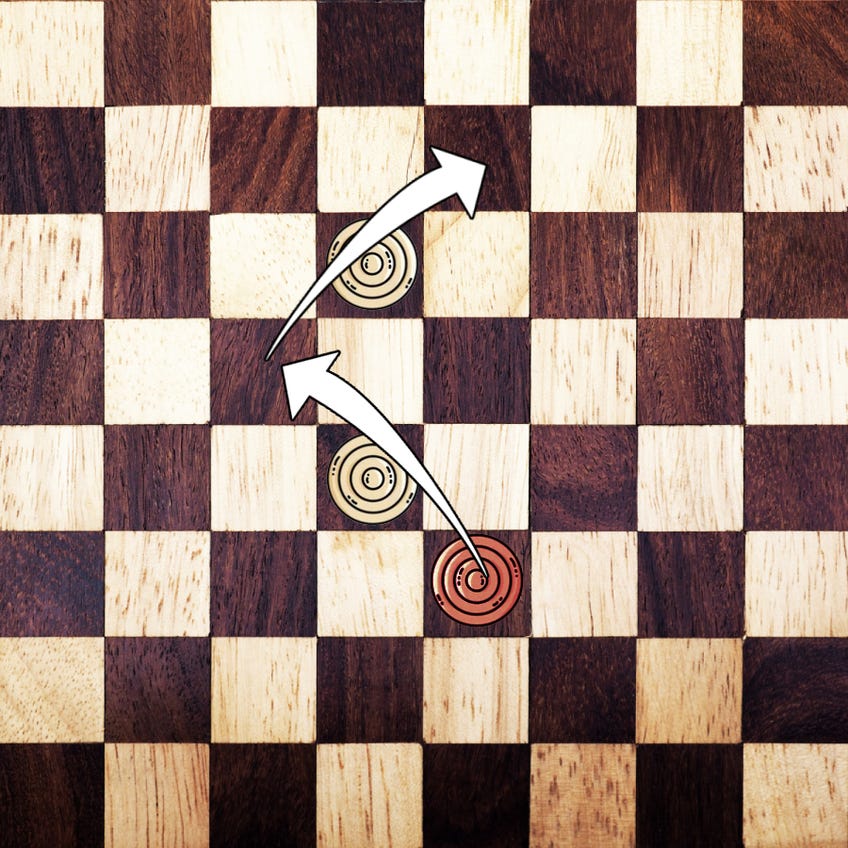
In checkers players can perform a single jump or multiple jumps in one turn. With multiple jumps the same rules apply as single jumps - you have to lookout for adjacent enemy pieces with an empty square behind. But in between jumps you can change the direction in which you're going.
For example, your first jump may be moving diagonally right. But after attacking that piece and landing in an empty space you may have an opportunity to capture a second, adjacent piece going diagonally left.
This allows for double or triple jumps if you're able to queue up hope - which is devastating for your opponent. Although, it's important to note that a normal piece can't jump backwards - even if it's part of sequence, a normal piece still can't jump backwards. The exception to this is the King, who can also jump backwards, but we'll come on to that in a bit.
Do you have to take a jump in checkers?
When a player has the opportunity to jump over a piece in their turn they must do it. Unfortunately, this may land them in a position which allows the opponent to counter and attack immediately back.
If someone is able to make a jump and overlooks this to move another piece, or simply refuses to make the jump, the opposing player has a few options. They can compel their opponent to go back and take the jump, cancelling out the illegal move they just made.
Alternatively, they can remove the piece from the board that should have jumped. This is known as a huff or having a piece blown and it doesn't count as a regular turn. The third course of action is deciding to let the illegal move stand, but you probably don't want to do that unless you're in an especially generous mood.
While players have to take a jump when it is available, if there are two different options they can choose which route to go down.
This can be strategically important. For instance, one route may allow a player to make a single jump and land in a safe square where an opponent can't take a piece on their next turn. While the other route may allow for a double jump but land a checker in a square where the opponent can attack straight back.
How do you turn a piece into a King?
Turning your pieces into Kings is crucial to winning a game of checkers.
To get a King you need to move one of your pieces into any of the four dark squares on the row furthest away from you (and closest to your opponent). Once you've done that, take one of the pieces that you had to discard (after being attacked) and put it on top of the piece that was just turned into a King.
Double stacking a piece signifies that it is a King. After doing this, your turn ends.
What does a King do in checkers?
The main advantage of having a King is increased movement. Unlike regular pieces on a checkers board, Kings are able to move forwards and backwards - which opens up new attacking and defensive opportunities. This means that they can take pieces forwards and backwards too - with the right strategy, a player is able to take many pieces in on go.

Like regular pieces, Kings can only move one square at a time and once again have to be moved diagonally to adjacent, darker squares.
How do you win at checkers?
There are two ways to win a game of checkers:
- Remove all your opponent's pieces from the board
- Stop your opponents from being able to move any of their pieces
The latter win condition can be quite tricky to execute as you need to make sure that when it comes to an opponent's turn they have no options left to move any pieces. This strategy requires planning, and if your opponent manages to outsmart you it may even lead to you finding yourself blocked when it comes to one of your turns. In that case your opponent wins.
What happens if it's a stalemate?
If you reach an impasse in checkers or draughts you can offer your opponent a draw.
If the opponent refuses this they have to force a win or show a decided advantage within 40 moves from then on.
If the opponent does not manage to remove any pieces or crown any more of their pieces as Kings during that time then it's a draw.
Checkers strategies for beginners
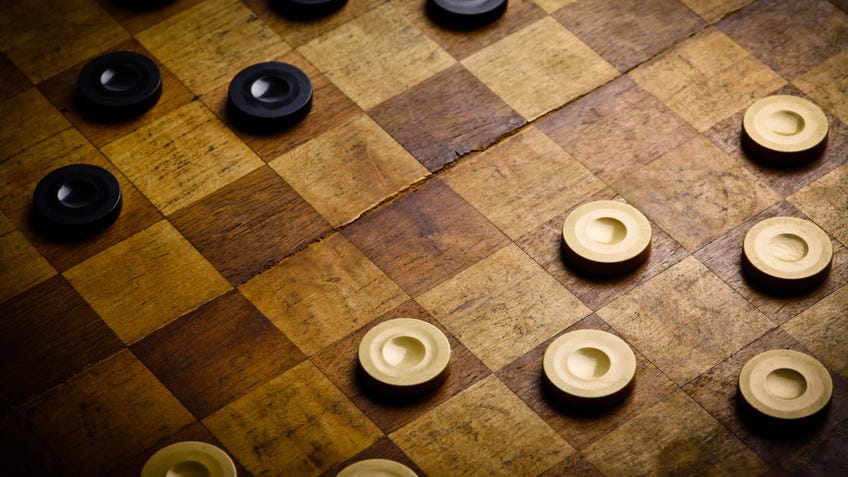
Just getting started in checkers and finding yourself on a long losing streak? Then try out these strategies to get more of a foothold:
Take control of the centre
When starting out in checkers it's easy to fall into the trap of playing passively or defensively, moving pieces to safe spaces on the side of the board at the beginning of each game. But playing defensively can open you up to problems later on.
So instead of moving to the side of the board in your opening moves, try to take the centre ground. If your opponent has a similar idea then you can try to get an equal share of the centre by matching moves, or forcing them into making a jump and then countering to re-take the centre.
Having pieces in the centre opens up more tactical opportunities which helps as a game progresses.
Opening traps
It can quickly feel like you're fighting an uphill battle if you manage to fall into an opening trap within the first few moves and lose several pieces.
To avoid this, when you're planning your opening moves try to be mindful of the positioning of your pieces, along with what you plan to do in your next turn and where your opponent could move to.
Lookout for any potentional gaps that you're opening yourself up to and any opportunities you may create for your opponent to perform jumps or multiple jumps.
Back four line
Keeping the back four pieces in place for as long as possible is a great way to improve your chances in a game. As it helps hold off your opponent from turning one of their pieces into a King for as long as possible. And if you have this strategy in mind it can also help with deciding what moves to take throughout the game. And while we're on the topic of Kings...
Kings
Turning one or several of your pieces into a King can also help turn a game in your favour.
If you have more Kings on the board than your opponent you'll have a strong advantage thanks to the pieces' increased movement.
While you will have more opportunities to attack when you get a King just beware of any moves you make that could allow your opponent to take your King off the board.
Other tips
As we mentioned earlier, it's easy to fall into the trap of playing defensively when you start playing checkers. But an offensive strategy and trying to take the initiative can make it easier to take control of a game and go onto win it.
Having said that, there are times when it's prudent to move pieces so they're together after successive turns. This helps provide backup to close any gaps that your opponent could attack and move into. Another useful thing to bear in mind is to try not to get too bogged down focusing on one area of the board.
It's easy to do this but especially in later stages of a game, where pieces are more spread out, you could end up missing opportunities to bring yourself closer to winning if you're just concentrating on one section of the board.
Frequently asked checkers questions
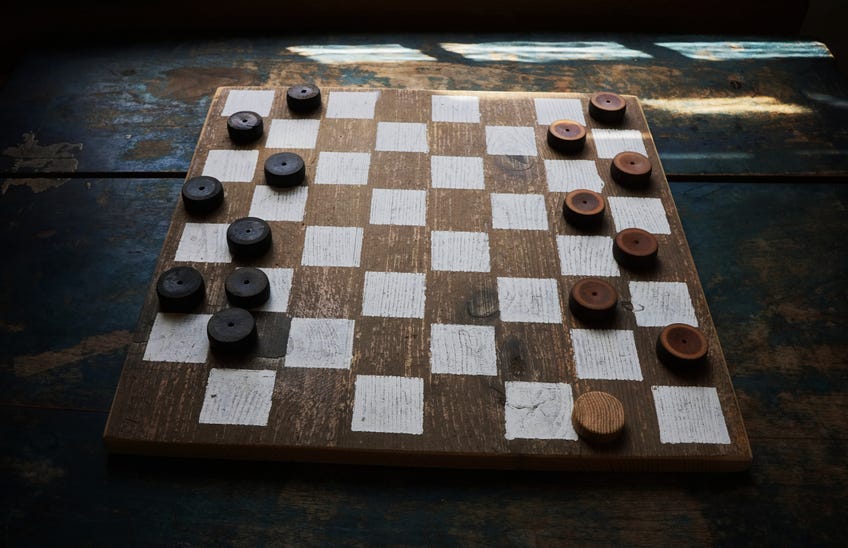
Can a single checker jump a King?
Kings are more powerful than regular checkers pieces thanks to the improved movement. But it doesn't mean Kings are immune to attacks from regular pieces.
Like any other piece, a King can be jumped over by both fellow Kings and regular checkers pieces. However, if a regular checkers piece is attacking a King it has to be moving forward.
Can you jump 2 pieces in checkers?
When you perform a jump in checkers it has to be attacking an adjacent enemy piece with an empty space behind it. You cannot jump over two diagonally adjacent pieces with one jump.
Is there a triple King in checkers?
In standard checkers rules you can only crown a piece as a King once. When this happens a piece is double stacked and it can move forwards as well as backwards one space at a time.
Variations of the checkers rules exist where you can turn a piece into a triple or even quadruple King when these pieces reach opposite sides of the board three or four times. These pieces have improved attacking moves, better movement and the ability to jump friendly pieces. But this isn't in the standard rules.
Keen to pick-up a few other traditional board games? Check-out our guides on how to play chess and how to play Go.
